Content
This article covers the best hot pepper varieties. They are of early, middle, late ripening. They grow in various conditions. Certain types of indoor hot peppers.
The best varieties of indoor peppers
Indian summer
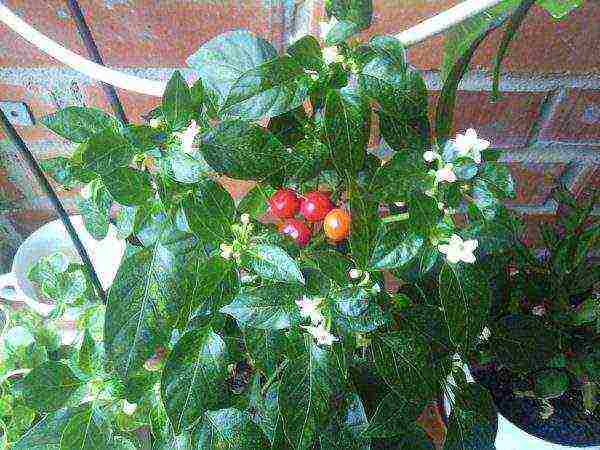 Indoor pepper Indian summer
Indoor pepper Indian summer
Shade-tolerant, undemanding plant. It can grow on a loggia for several years, or on the ground as an annual plant. The bush is not high, 30-40 cm, it is covered with small spherical peppers, differing in color variety. Red is used without additional processing. The wall thickness is 3 mm, the taste is sweetish with sourness, spicy.
Hungarian yellow
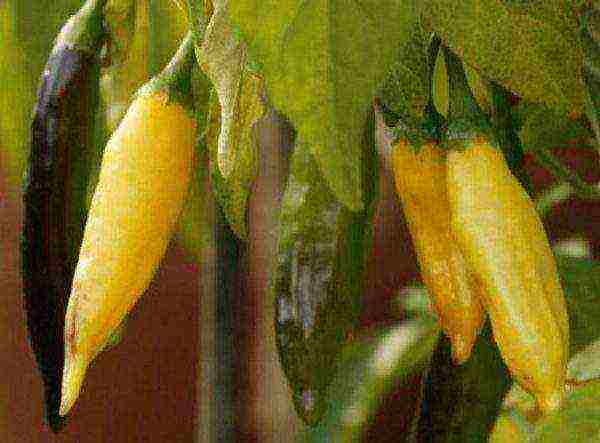 Hot peppers Hungarian yellow
Hot peppers Hungarian yellow
Early ripe, adapted to cold weather, small bush, about 25 cm... The vegetable looks like a cone hanging down. In the process of formation, yellow, when ripe, turns red. The wall thickness in the section is 4 millimeters. Juicy, sweetish, semi-sharp.
Goldfinger
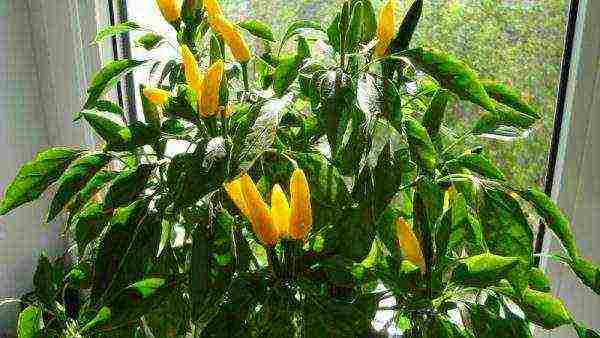 Hot Pepper Goldfinger
Hot Pepper Goldfinger
Light-loving, early ripening plant, profusely flowering, 25 cm high. Pods up to 5 cm long, yellow... It grows well and gives a lot of production on lighted windowsills.
The plant is grown as an ornamental plant with inedible fruits.
Filius Blue
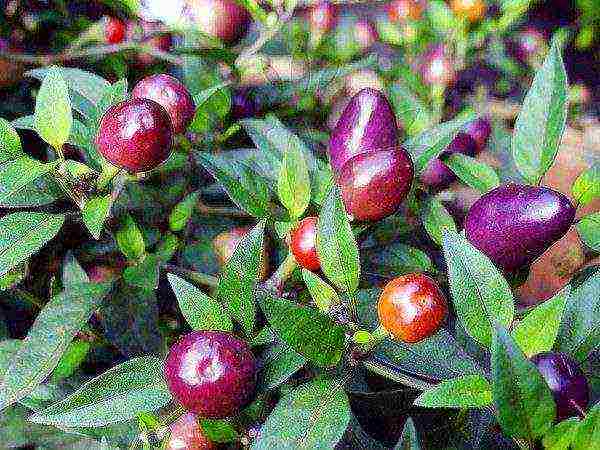 Hot pepper Filius Blue
Hot pepper Filius Blue
A beautiful perennial plant with fruits that can be eaten. The height of the bush reaches 20 centimeters, unripe peppers are purple, the red color indicates its ripeness. For the plant, it is necessary to provide a sufficient amount of light, moderate watering, moist air. If grown in an apartment and properly cared for, it will bear fruit for a whole year.
The best spicy peppers outdoors
Adjika
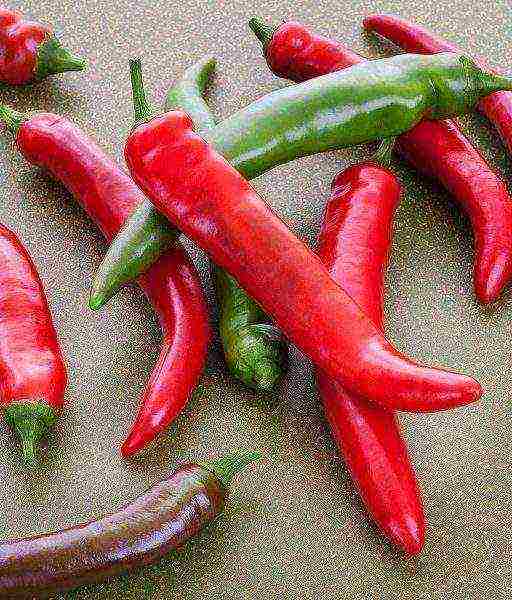 Hot pepper grade Adjika
Hot pepper grade Adjika
Medium early, tall. Grows up to a meter in height. The bush is strong, lush. The fruits are large, conical, bright, red, spicy with a pleasant aroma.
For mother-in-law
 Hot pepper grade For mother-in-law
Hot pepper grade For mother-in-law
Early, with a high yield. Below average height, cone-shaped fruits, red, strong smell, pungent taste.
The Queen of Spades
 Hot pepper grade The Queen of Spades
Hot pepper grade The Queen of Spades
Mid-season. Bushes are small, spherical. There are a lot of fruits, of varying degrees of maturity and color. It looks very nice. Grows well in shady areas. The fruits are cone-like, growing upward. The taste is spicy with sweetness.
Dragon tongue
 Hot Pepper Dragon's Tongue
Hot Pepper Dragon's Tongue
Mid-season. The bushy plant grows up to a meter in height, unpretentious to care for. Ripe fruits are long, rich red color, burning, with a pleasant aroma.
Goes to the production of paprika.
Bully
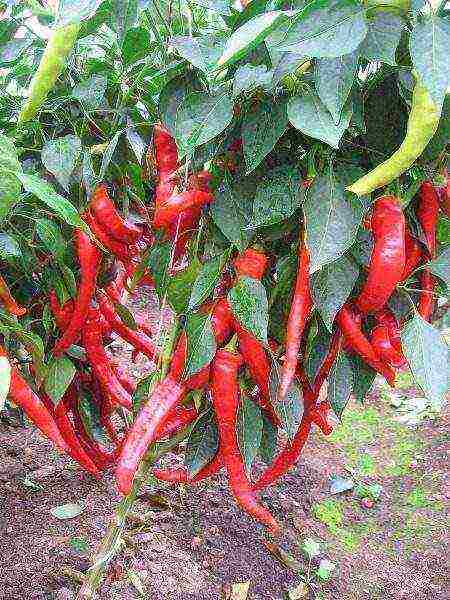 Hot pepper Bully
Hot pepper Bully
Mid-season. The bush is small, semi-spreading, grows up to 70 cm... The fruits are long, proboscis-shaped, red. In a section with a thickness of 1.5-2 mm. High resistance to cold weather, high yield. Low aroma, semi-pungent taste.
Doesn't like shadow.
The best varieties of early ripe peppers
Impala
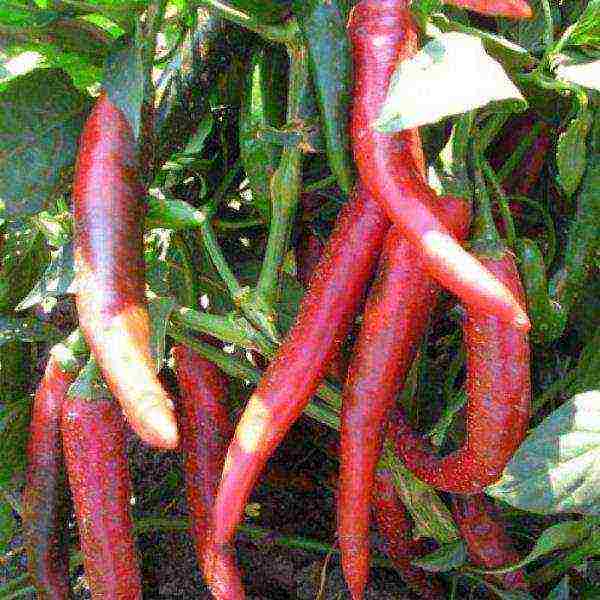 Hot Impala Pepper
Hot Impala Pepper
It tolerates heat well, ripens early, brings a large harvest. The bush is massive, reaches a height of 70 cm, dotted with peppers... They are large, weighing 80 grams. When ripe, it becomes deep red. The vegetable has an interesting taste and pungency. Reference! Resistant to tobacco mosaic virus.
Wit
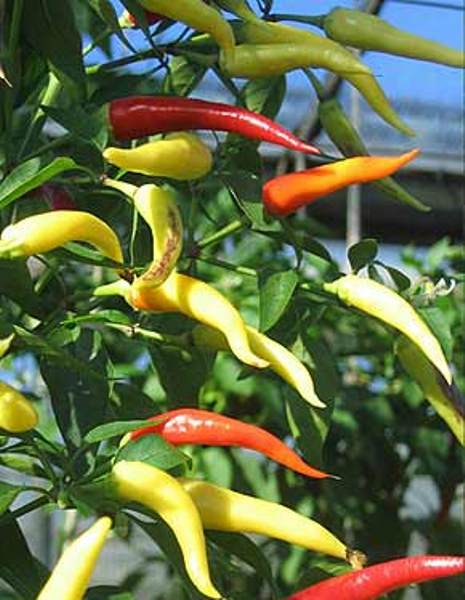 Hot pepper grade Wit
Hot pepper grade Wit
Early ripe. Grows in open and closed ground.The bush is small, medium height, large-leaved. Fruits are red, with a dark shade, shiny, conical, growing upwards. The yield is high. It is not affected by diseases and temperature changes.
The variety tolerates drought well, but cannot tolerate poor lighting. Suitable for drying, storage, salting.
Tula
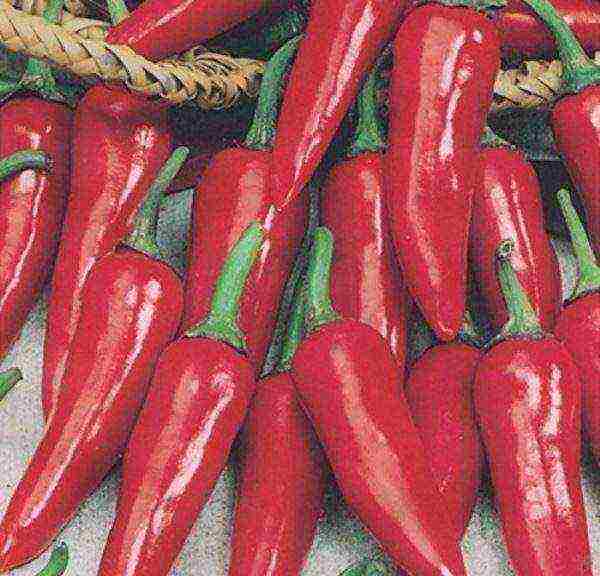 Hot pepper Tula grade
Hot pepper Tula grade
Early ripe. Grown in the open field and under a film. Medium bush, cone-shaped peppers, large, hot, red. The variety is high-vitamin, fruitful, plastic.
The best mid and late ripening varieties
Vizier
 Hot pepper vizier
Hot pepper vizier
Late maturing. Grows indoors. The fruits are red, weighing up to 20 g. Medium spicy taste. The yield is good. It is used for the manufacture of paprika, salt, conservation.
Astrakhan
 Hot pepper grade Astrakhansky
Hot pepper grade Astrakhansky
Mid-season ripening period. High yield, cultivated in open field with different climatic conditions. The fruits are small, red. The taste is acutely pungent. The pungency is determined by the capsaicin content. It is successfully used for culinary and medicinal purposes. Pepper tincture will relieve sciatica. Fresh pulp will heal abscesses. Hot pepper stimulates appetite, helps with pain, fever.
Ram horn
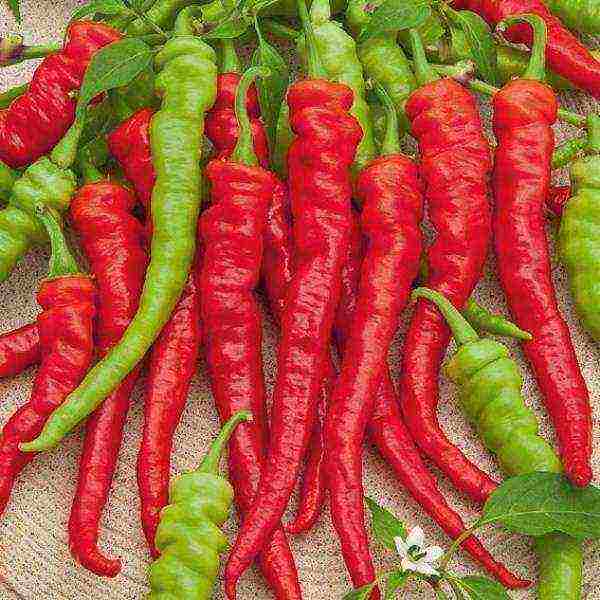 Hot Pepper Lamb Horn
Hot Pepper Lamb Horn
Mid-season. Unpretentious in cultivation, but does not tolerate stagnant water. With proper care, it gives a high yield. The pods are elongated, twisted, like a ram's horn. The taste is not very pungent when well watered. If there is little watering, hot weather, the pepper will grow sharper. Suitable for trade, export.
Cayenne
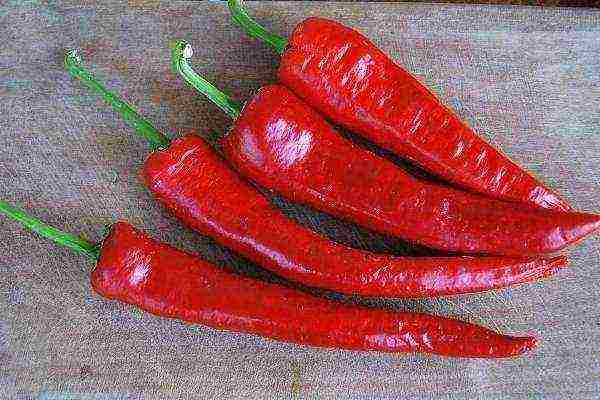 Hot pepper grade Cayenne
Hot pepper grade Cayenne
A relatively new species. It grows in greenhouses and in a room (seeds are pre-planted for seedlings). The yield is high. Fruits are thin, of medium length. The bushes are tall, reaching one and a half meters. It is imperative to tie up. The taste is relatively pungent. It is used for cooking, canning, processing into powder.
It is planted in open ground with seedlings.
Tabasco
 Hot pepper Tabasco
Hot pepper Tabasco
Shrub hot peppers. Grows on bushes in bunches upward. Fruits are orange-red, small. The pulp is juicy, fleshy, spicy. Productivity is high, disease resistant. The famous Tabasco sauce is made from this variety.
Popular varieties for giving
Among summer residents and owners of personal plots, Double Abundance, Superchili, Ogonyok are very famous.
Double abundance
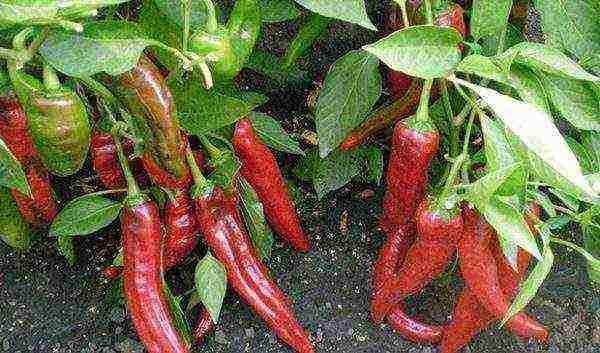 Hot Pepper Double Abundance
Hot Pepper Double Abundance
Early ripe variety. Grows in open and closed ground. Ranks first in terms of yield. Peppers are brightly colored, weigh up to 80 g... Dry peppers can be stored for several years without losing their appearance and taste. Equally good fresh and canned. Resistant to disease and heat.
Superchili
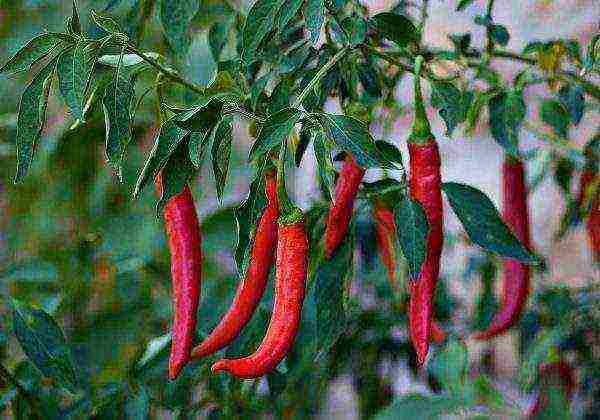 Super chili hot pepper
Super chili hot pepper
An early ripe hybrid variety. The yield is high, the taste is pungently burning. Super chili peppers are large, located under the foliage. Fully ripe fruits of almost cherry color... Eaten fresh, dried, salted.
This variety should not be grown next to other peppers in order to avoid over-pollination of the plants.
Twinkle
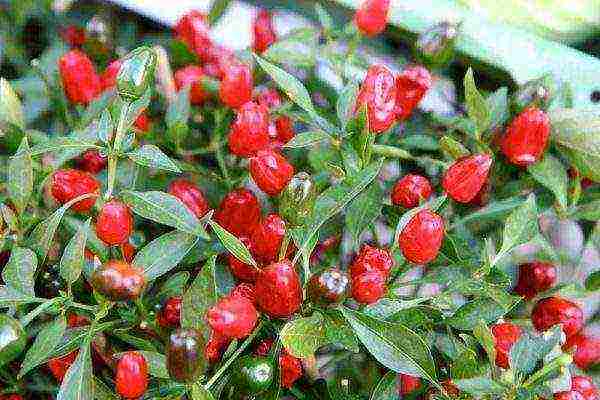 Hot pepper Spark
Hot pepper Spark
Spark is a fairly well-known, popular variety. Medium early ripening. Feels great outdoors and greenhouses. Fruits are not large enough, bright red. There are many of them on the bushes, they look like bright lanterns. Taste with special pungency and peppery aroma. This is due to the increased content of coloring pigments and solids. The fruits are dried naturally, stored in a glass container under a lid.
Resistant to bacteriosis and verticellosis wilt.
From such an abundance of piquant peppers, you can choose those that are suitable for taste, color, ripening time, types of storage, specifically for this site.
15 January 2017
ditim
Views: 1560
For lovers of savory, spicy dishes bitter pepper Is a welcome ingredient. Of course, you can buy it on the market as well. But grown on your own summer cottage, with your own hands, it will be doubly delicious! Varieties of bitter (hot) peppers not as much as sweet. If we compare the data of the State Register, we get 708 varieties against 69. The full list can be viewed here and in this article we will consider the best varieties of hot pepper with a photo.
Popular varieties
Bitter pepper variety "Adjika"
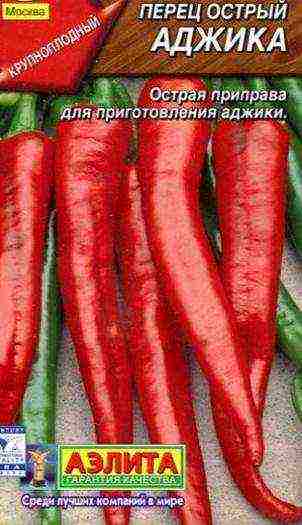 Short description:
Short description:
A mid-early variety of hot pepper.
Suitable for outdoor cultivation.
Fruit weight on average 90 g
Shape: elongated conical
Color: red
Flesh: thick, dark red, pungent taste, peppery aroma.
The plant is tall, but no support is required.
Application: as a seasoning for soups, sauces, meat dishes and canning. It is used dried and ground.
Bouquet East F1
 Short description:
Short description:
Mid-season hybrid.
Fruit weight: up to 130 g
Shape: elongated-conical, with a pointed tip
Color: red
Plant height: up to 1 meter.
Application: for drying and paprika.
Vizier
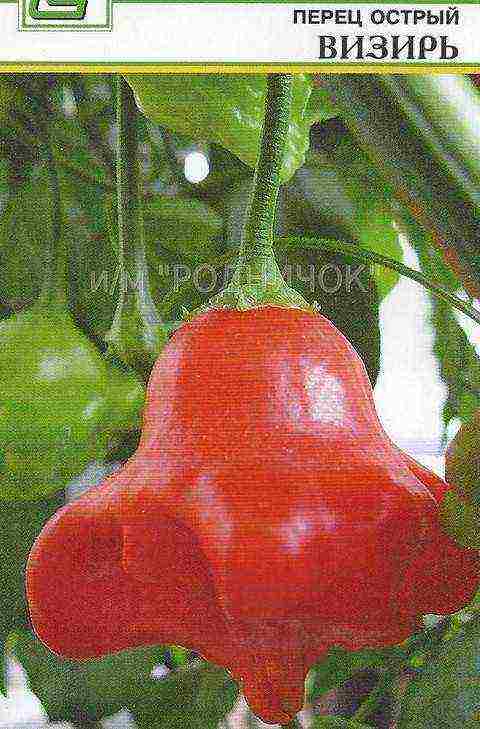 Short description:
Short description:
Late maturing.
Fruit weight on average 10 - 20 g
Wall thickness 2-3mm.
Shape: turban
Color: light green in technical ripeness, red in biological ripeness.
Plant: tall, vigorous, semi-spreading.
Taste: mild.
Application: for the preparation of paprika and pastes, for salting and canning.
Gorgon F1
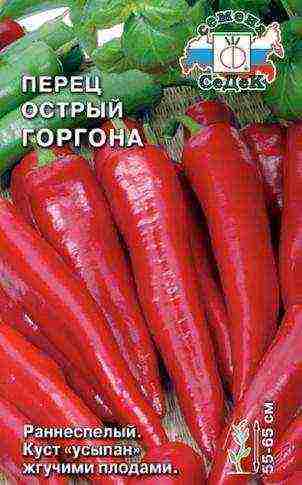 Short description:
Short description:
Late maturing.
Fruit weight on average 120 - 170 g
Shape: prismatic
Color: green in technical ripeness, golden yellow in biological ripeness.
Information from the label:
Early maturing (97-105 days) hybrid for open ground and film shelters. The plant is compact, 55-65 cm high, strewn with many burning rich-red cone-shaped fruits weighing 20-25 g. It is characterized by amicable and long-term fruiting, high decorative effect of the bush.
Hot pepper "For the mother-in-law"
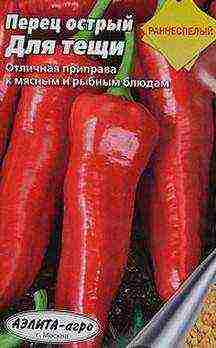 Short description:
Short description:
Early ripe.
For open ground
Plant height: up to 60 cm, does not require formation
Fruit weight on average 65 g
Shape: elongated-conical
Color: bright red
Taste: spicy, spicy, with a strong pronounced aroma.
Amicable ripening of fruits. High productivity.
Application: as a seasoning for meat and fish dishes
Hybrid "Medusa F1"
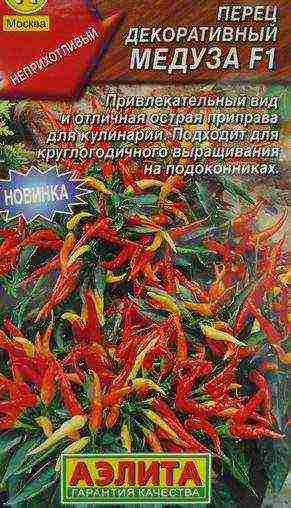 Short description:
Short description:
Early ripe.
Plant height: up to 20 cm
Fruit length: up to 5 cm
Shape: curved
Color: red and yellow
The plant is light-loving, does not tolerate drying out of the soil and dry air, therefore it requires frequent spraying of the foliage.
Lightning white F1
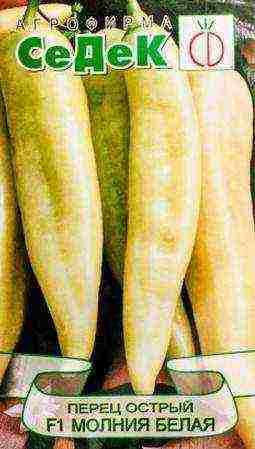 Short description:
Short description:
Medium early.
For film greenhouses
Shape: elongated-conical
Color: white at biological maturity.
Taste: hot-spicy
Plant height: up to 110 cm.
Application: for hot sauces and seasonings, marinades and pickles.
High content of sugars and vitamins. Bears fruit abundantly. The variety is resistant to adverse weather factors and diseases.
Lightning red F1
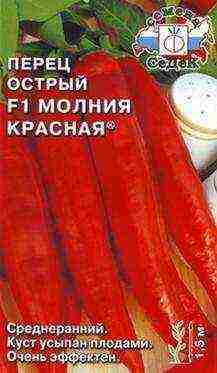 Short description:
Short description:
Medium early.
For film greenhouses.
Fruit weight on average 100 g
Shape: narrow-triangular, with a sharp tip.
Color: intense red, dark red.
Taste: semi-sharp, with a peppery aroma.
Plant height: up to 1.5 meters
Lightning black F1
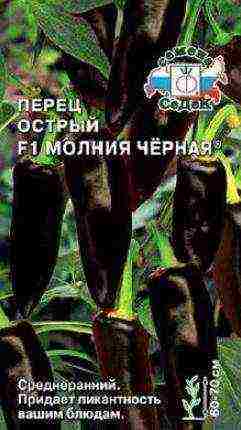 Short description:
Short description:
Medium early.
For film greenhouses.
Fruit weight on average 80 - 90 g
Shape: narrow-triangular, proboscis
Color: dark purple in technical ripeness, dark red in biological ripeness.
Taste: semi-sharp, with a peppery aroma.
Application: in home cooking, for making sauces and seasonings.
F1 Super Chili
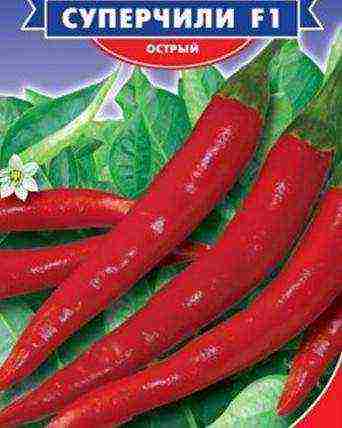 Short description:
Short description:
Early ripe.
Fruit weight on average 16 - 25 g
Color: green in technical ripeness, cherry red in biological ripeness.
Taste: hot
Plant height: 40 - 60 cm
Application: for consumption fresh, dried and canned.
Fiery maiden
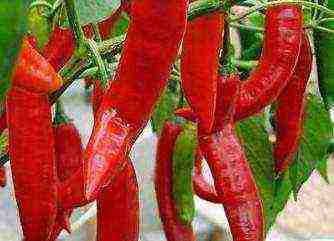 Short description:
Short description:
Mid-season.
For open ground and film shelters.
Fruit weight on average 3.5 g
Shape: elongated-conical
Color: green in technical ripeness, red in biological ripeness.
Taste: spicy, strong peppery aroma.
Plant height: 100 to 140 cm
Application: as a spice, canning.
Red fat man
Short description:
Mid-season.
For open ground.
Fruit weight on average 60 - 90 g
Shape: conical
Color: dark red at biological ripeness.
Taste: spicy, pungent.
Application: as a seasoning, spice, for pickling and pickling, for cooking homemade dishes.
Information from the label:
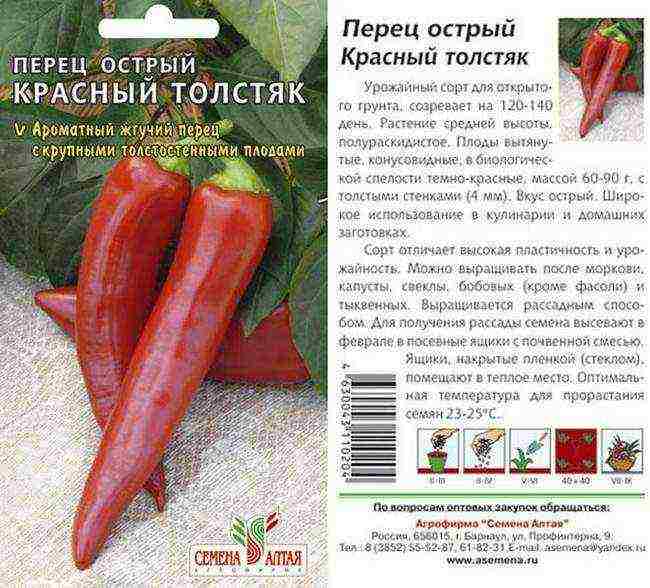
Variety "Indian Summer"
Short description:
Early ripe variety. Ripens in 4 months.
Shrub type plant. Suitable for growing on a windowsill and in the summer on a balcony.
Plant height: 30-40 cm
Fruit shape: spherical, round, ovoid
Color: bright red in biological ripeness
Taste: spicy, with a pleasant aroma
The variety is unpretentious, tolerates shade well, grows well in indoor conditions.
Application: for medicinal purposes, as a seasoning.
Information from the label:
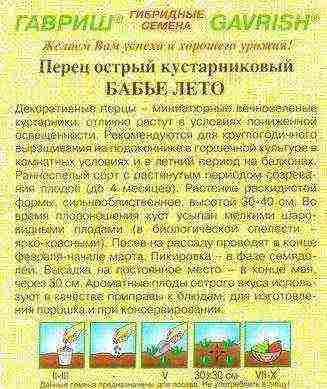
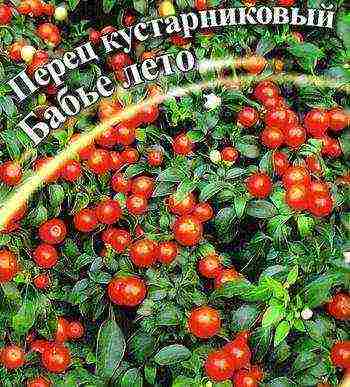
Double abundance
Short description:
An early ripe hybrid.
For open and closed ground.
Fruit weight on average 50 - 80 g, thick wall
Shape: proboscis
Color: bright red
High productivity. Long-term storage in a dried form. Resistant to viruses and high temperatures.
Application: fresh, dried and for canning.
Information from the label:
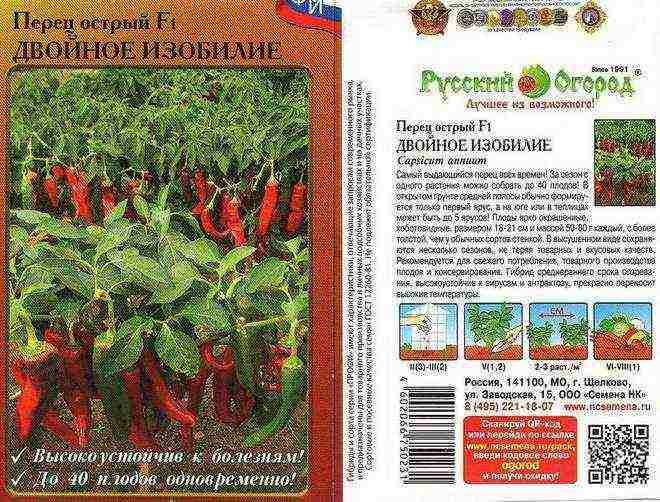
Twinkle
Short description:
Mid-season.
For open ground and film shelters.
Fruit weight on average 20 g
Shape: narrow conical, long, glossy fruit
Color: green in technical ripeness, dark red in biological ripeness.
Taste: spicy, strong, peppery aroma.
Plant height: 45-55 cm
Resistant to bacteriosis and verticillary wilt.
Application: for canning and home cooking.
Information from the label:

The Queen of Spades
Short description:
Mid-season.
Suitable for growing on a windowsill, balcony. Refers to the decorative varieties of bitter pepper.
Shape: conical
Color: in technical ripeness purple, in biological ripeness dark red
Plant height: 20 - 30 cm
Taste: burning, aromatic
Application: for seasonings, spices, canning.
Information from the label:
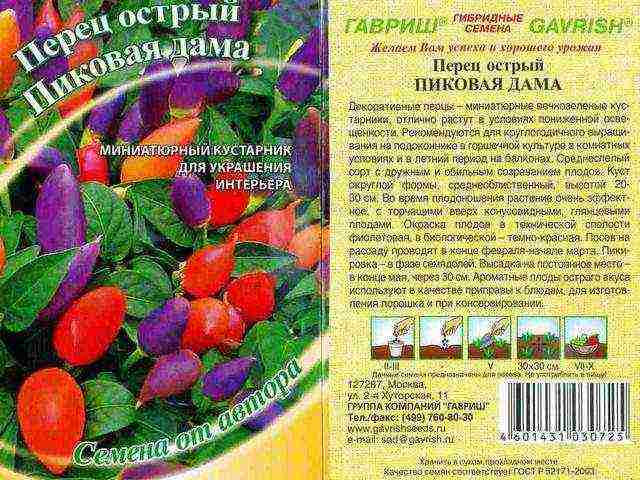
Tone
Short description:
Medium early.
For open ground and film shelters.
Fruit weight on average 15 g
Shape: conical
Color: green in technical ripeness, red in biological ripeness.
Information from the label:

Salute
Short description:
Medium early.
For greenhouses, balconies, open terraces, indoor conditions.
Fruit weight on average 6 g
Shape: conical
Color: dark green in technical ripeness, light orange in biological ripeness.
Plant height: 20cm
Information from the label:
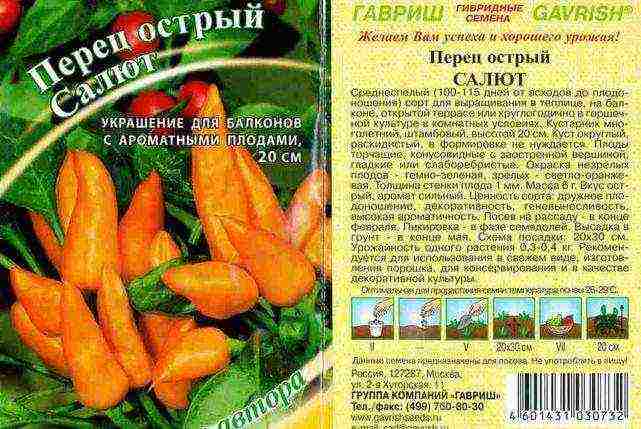
Varieties from the State Register
In total, 69 varieties of bitter (hot) pepper are registered in the State Register. Here are some of them:
Unshakable classics
Habanero
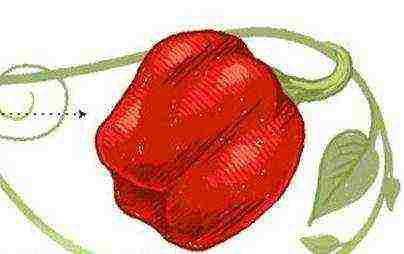 For cultivation, including as a pot culture.
For cultivation, including as a pot culture.
Fruit weight: up to 15 g
Shape: heart-shaped.
Color: orange, red, chocolate.
Taste: hot.
Recognized as one of the hottest hot peppers in the world. High productivity. Requires regular, abundant watering.
Jamaican red
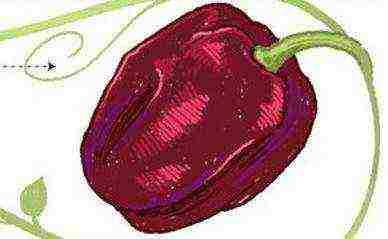 For cultivation, including as a pot culture.
For cultivation, including as a pot culture.
Early ripening.
Shape: resembles a bell
Color: red.
Regular watering and feeding.
There are over 3000 varieties of hot peppers. Hot pepper varieties differ in the degree of pungency, cultivation methods, and the speed of plant development. Below is a description of the best and most popular pepper varieties.
What are the best varieties?
The best varieties of hot pepper for open ground are distinguished by a high degree of productivity and pleasant taste.

- "Burning bouquet" bears fruit in the open field and in greenhouses. Gives big yields. Medium-sized bushes - 0.5 meters. The pods are long - 10 cm, 25 grams each. The pulp is fragrant, very spicy.
- "Chinese fire" transportable, can be stored for a long time. Fruiting in 100 days after germination. The plant is 0.5-0.6 m in height, the pepper is long - 21-23 cm, weighing 70 grams.
- "Miracle of the Moscow Region" - a high-yielding variety of bitter pepper. Up to 3.9 kg of product is collected from a square meter. The fruits are fleshy, not very pungent, but popular for their sweet pepper notes and zesty aroma. Pods up to 50 grams, 21-25 cm long.
- "Jubilee Vniisok" grows up to 1.3 meters in height, tied up in advance. Ripens in 100 days from germination. The pods are very long, up to 30 cm and weighing up to 30 grams. Red pepper, fleshy, slightly spicy, but fragrant. Productivity - 2 kg / m. sq.
In addition to those listed above, the popular varieties include Jalapeno, Indian Elephant, Habanero Tobago seasoning, Double abundance, but they will be discussed a little below.
What are the earliest pepper varieties?
Early varieties of hot peppers are very popular, because hot peppers are required throughout the year, not just in the fall. Some of the species can be grown at home, others outdoors.

- "Trinidad small cherry " - is harvested after 80 days from the day of germination, but only after six months can it be eaten, since from the moment of collection it begins to ripen at room temperature. The plant grows up to 0.9 meters. Fruits are roundish, 25 mm in diameter. It is a small plant, but quite tasty. The pulp is red, sometimes orange. Its peculiarity is that, despite the bitter taste, pepper has a slight cherry aroma.
- "Chilean heat" - the early species matures 2.5 months after germination. It can be grown outdoors, at home or in a greenhouse. The pods reach 20 cm, sweet-spicy, aromatic. They are eaten fresh or dried and ground into powder for use in various dishes.
This also includes Habanero, Jalapeno and Serrano.
What are the hottest peppers?
Hot peppers are very popular in modern cooking, they are often added to dishes of different nationalities. Listed below are the most famous hot pepper varieties that can be grown in a greenhouse or outdoors.

- Jalapeno ripens 80 days after sprouting. Bushes up to a meter high, it is recommended to tie them up. On the bush grows about 35 pungent peppers, which, when ripe, become bright red.
- «Habanero Tobago seasoning " has very productive bushes, giving up to 1000 pods weighing 15 g each season. Externally, the pods are unusual, their crust resembles a crumpled tissue. The variety is very pungent, with a fruity aroma, very popular for Mexican cuisine. The color of the pepper can be white, yellow, green. Red and even brown.
- "Habanero chocolate" or "Congo black" grows up to 120 cm. Fruits after ripening have a chocolate brown color, not long up to 6 cm, but 3 cm wide. Ripens in 100 days. A very spicy variety, eaten carefully!
- "7 Pot Primo" has plump fruits with a characteristic taper towards the tip, reminiscent of a scorpion's sting. Differs in record burning qualities, its popular name - "fiery demon". Grows in greenhouses and outdoors up to 1.3 meters in height.
- "Adjika" inferior in sharpness to the first four varieties, but for an inexperienced cook it is better to start with this particular variety. Large pepper - up to 90 g, similar to sweet. The pods are fragrant, fleshy.
The varieties “Habanero Orange”, “7 Pot”, “7 Pot Gigantic”, varieties of the type “Capsicum annuum” also have very burning qualities.
What varieties of peppers are grown outdoors? 
Hot peppers for outdoor cultivation have strong immunity to temperature extremes, pest and disease resistance.
Of those species that best take root in any climate, it is worth highlighting "Ogonyok", "Ukrainian Bitter", "The Queen of Spades", "Fiery Bouquet", "Fiery Maiden", "Elephant Trunk", "Superchili", "For Mother-in-law" , "Tongue of the Dragon", "Astrakhan 628", as well as the eastern "Aladdin", "Chinese Fire" and the well-known "Cayenne".
What varieties are recommended for greenhouses?
Greenhouse varieties of hot peppers give large yields only with proper care.They are often grown at home, as the conditions are similar, and some varieties are small and allow them to be placed in an average pot right on the windowsill.

- "Double abundance" gives a large yield when grown in greenhouse. On a bush, about 40 ripens in several tiers. Elongated pods - up to 21 cm, weighing 50-80 g. Resistant to diseases, pests, drought and heat.
- "Indian elephant" bears fruit 100 days after sprouting. Tall bushes 1.3 meters, it is best to tie them up, as they can fall under the weight of the branches. The variety has a mild pungency with a sweet pepper flavor. It can be grown in a greenhouse and in the open field, but in a greenhouse the variety bears fruit much better and gives 2 kg of yield per square meter.
- "Hungarian yellow" can be easily grown not only in a greenhouse, but also at home, on a windowsill. The bushes are small, the pods are up to 60 grams, the taste is not very spicy.
- "Filius blue" an ornamental variety that is often used to prepare all kinds of dishes. The plant is small, up to 20 cm. The taste is bitter, pungent, the color range of fruits is very diverse.
- "Small miracle", probably the most common type of greenhouse or indoor plant, does not require serious maintenance, grows quickly. The fruits are small, up to 5 grams, but spicy and tasty.
This culture may not be as popular with summer residents as its counterpart - sweet pepper, but the fact that you cannot do without it in cooking is for sure. A native of Central and South America, bitter pepper has taken root in our country, only it is usually grown as an annual (in a greenhouse or greenhouse).
Description of hot pepper
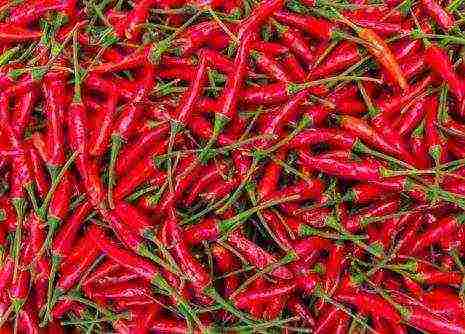
Hot, spicy, chili - these are the names that bitter peppers have and they are all correct. Europeans owe the appearance of this plant to H. Columbus, who brought sharp pods after his famous journey to another continent.
Characteristic
The plant belongs to the Solanaceae family, is, like many tropical crops, light and heat-loving. Height varies from 30 cm to one and a half meters (it all depends on the variety). There are a lot of varieties of bitter pepper, so gardeners always have a choice of which variety to choose for themselves.
Leaves are oval, varying from light green to purple in color. The fruits are pods, ranging in length from one and a half to 15-16 cm. Their shape is also different, and there are not only classic elongated pods, but also fruits resembling a berry, turban, barrel in shape.
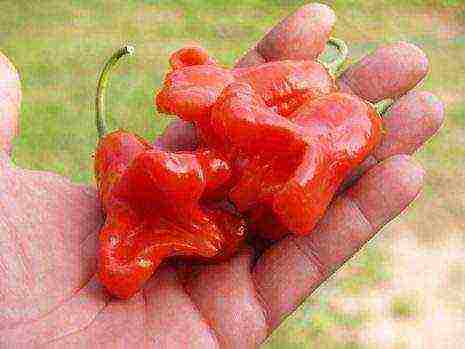
During the period of technical maturity, the pods of such peppers are usually green, although the skin tone can also be creamy, yellow. In the stage of full maturity, they are usually red, and the hue can change several times - from green to yellow, purple, bright scarlet or orange.
According to the growing season, like many other vegetable crops, pepper is divided into groups:
- early;
- mid-season;
- late ripening.
When choosing a variety for a site, one must take into account the time when the first fruits begin to ripen, as well as the height of the bushes, the degree of pungency of the fruits. Bitter peppers can be grown very well at home, choosing undersized varieties. Today, specialized stores sell a huge selection of peppers for every taste, so you can buy varieties of any height, sharp, semi-sharp, for planting in open ground, in greenhouses or greenhouses, on the balcony.
ON A NOTE! Seeds are not harvested from hybrids for cultivation, only varieties of peppers are suitable for this.

In order to have time to get the harvest, the culture is grown in seedlings. Bitter pepper is one of those garden representatives, the sowing of seeds for seedlings of which begins one of the first.


